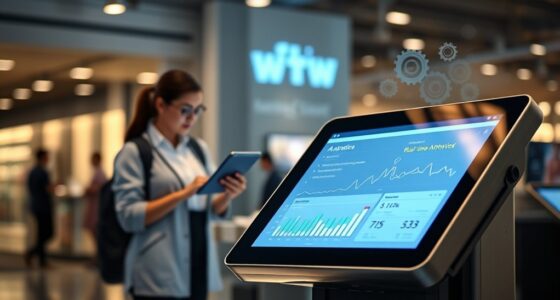Implementing HR automation can substantially boost your efficiency by streamlining recruiting, onboarding, payroll, and employee management tasks. It reduces manual work, minimizes errors, and guarantees compliance, saving you time and resources. Automated processes provide employees with easy access to pay stubs, benefits, and leave info, while speeding up workflows. This allows you to focus on strategic HR initiatives. Keep exploring how HR automation can transform your operations and open new levels of productivity.
Key Takeaways
- Automates repetitive HR tasks, saving time and reducing errors across processes like onboarding and payroll.
- Enhances employee onboarding with online forms, checklists, and digital signatures for a seamless experience.
- Streamlines payroll processing by automating data collection, tax deductions, and compliance, ensuring accuracy and timeliness.
- Empowers employee self-service portals for pay stubs, leave balances, and documents, reducing administrative workload.
- Accelerates HR workflows, improves accuracy, and supports strategic initiatives by minimizing manual administrative tasks.

Have you ever wondered how HR departments manage to handle endless paperwork and repetitive tasks so efficiently? The secret lies in HR automation, a technology-driven approach that streamlines processes and frees up your time to focus on more strategic initiatives. Two key areas that benefit immensely from automation are employee onboarding and payroll processing. When these tasks are automated, HR teams can reduce errors, improve accuracy, and accelerate workflows, making the entire employee lifecycle smoother.
Employee onboarding, for instance, used to involve stacks of paperwork, multiple in-person meetings, and manual data entry. Now, with automation, new hires can complete necessary forms online before their first day, ensuring all required documentation is collected efficiently. Automated onboarding systems guide new employees through each step, providing checklists, tutorials, and digital signatures. This not only minimizes administrative overhead but also creates a positive first impression. You can guarantee that paperwork is completed correctly the first time, reducing delays and administrative follow-ups. Additionally, automated onboarding can integrate with other HR systems to set up employee profiles, assign training modules, and schedule orientation sessions automatically. This streamlines the entire process, making new hire integration faster and more effective.
Payroll processing, another critical HR function, has traditionally involved manual calculations, paper timesheets, and complex tax compliance procedures. Automation transforms payroll management into a seamless, error-free process. Automated payroll systems gather hours worked, deduct taxes, handle benefits, and generate paychecks with minimal manual intervention. You don’t have to worry about calculation mistakes or missed deadlines, as these systems ensure compliance with legal standards and internal policies. The automation also provides employees with direct access to their pay stubs, tax documents, and leave balances through self-service portals—saving HR teams from answering routine queries and reducing administrative workload. Furthermore, automated payroll solutions can handle multi-state or international payroll, accommodating different tax laws and currency conversions effortlessly.
Frequently Asked Questions
How Does HR Automation Impact Employee Morale?
HR automation can boost employee morale by increasing engagement and fostering a positive workplace culture. When you automate routine tasks, employees feel more valued and less overwhelmed, allowing them to focus on meaningful work. This leads to higher job satisfaction and a sense of empowerment. As a result, your team becomes more motivated, collaborative, and committed, creating a healthier, more productive environment where everyone feels appreciated and engaged in the company’s success.
What Are the Initial Costs of Implementing HR Automation Systems?
You’ll need to conduct a thorough cost analysis to determine the initial expenses of HR automation. This includes software licensing, hardware upgrades, and training costs. Vendor selection plays a key role, as choosing the right provider affects your budget and future scalability. Expect upfront investments, but keep in mind that streamlining HR processes can lead to long-term savings, making the initial costs worthwhile.
How Secure Is Sensitive HR Data With Automation Tools?
You can be confident that your sensitive HR data stays secure with automation tools. They use data encryption to protect information from unauthorized access, ensuring confidentiality. Access controls limit who can view or modify data, adding an extra layer of security. Regular updates and audits help identify vulnerabilities, so your HR data remains protected. Overall, automation tools are designed to keep your information safe while streamlining HR processes.
Can Small Businesses Benefit From HR Automation?
You might think small businesses can’t benefit from HR automation, but studies show they actually do. Automation helps reduce costs and streamlines processes, making HR tasks more manageable with fewer resources. By adopting these tools, you can improve accuracy, save time, and focus on growth strategies. So, yes, even small businesses can gain significant advantages, enhancing overall efficiency and competitiveness in today’s fast-paced market.
What Training Is Needed for HR Staff to Adapt to Automation?
You need to focus on training needs that enhance your HR staff’s skill development to adapt to automation. Provide targeted training on new software, data management, and analytics tools. Encourage continuous learning through workshops, online courses, and hands-on practice. This makes certain your team stays updated with evolving technology, improves efficiency, and confidently leverages automation to streamline HR processes. Investing in their skills directly benefits your business’s overall HR performance.
Conclusion
By embracing HR automation, you streamline processes and boost efficiency. Imagine onboarding a new employee in half the time, freeing up your HR team for strategic tasks. For instance, a mid-sized company implemented automated payroll, reducing errors and processing time. With these tools, you can focus on what truly matters—building a stronger, more engaged workforce. Ultimately, automation isn’t just a trend; it’s the key to transforming your HR operations for better results.









